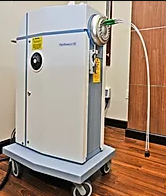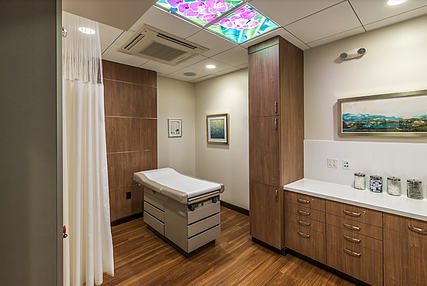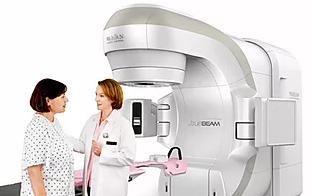Radiation Therapy is a one of the best options for treatment of Breast cancer for multiple reasons:
- It’s just as good if not better than traditional mastectomy treatment at eliminating cancer and reducing recurrence, but
- It’s much faster and incredibly more convenient when compared to several surgeries
- it’s completely safe as the radiation is highly targeted, no other organs or tissue is ever at risk
- The cosmetic results are tremendous, you don’t need new breasts or reconstruction surgery
- And when detected early has a 95% success rate
At the Innovative Cancer Institute there is no “one-treatment-fits all” approach to patient care, especially when it comes to Breast Cancer, the most common cancer diagnosed in the US.
Dr. Beatriz Amendola along with our radiation oncology staff will partner
with you throughout your entire course of treatment and provide the best individualized cancer therapy using the latest treatment techniques. We work directly with your referring doctors and jointly guide you throughout your treatment course.
About Breast Cancer
Breast cancer is the most diagnosed cancer among women in the US, second only to skin cancer. Statistics show that 1 out of 8 women will be diagnosed with breast cancer in their lifetime.The cure rate for breast cancer is exceptionally high, especially when detected early, reaching up to 95% success rate; however, it remains the second leading cause of cancer death among women.
Why is this the case in today’s advanced technological world? Breast cancer is actually a complicated type of cancer – no two patients are the same, so every woman needs to be evaluated and treated individually. Several types of breast cancer can behave aggressively– spreading quickly to lymph nodes and from there throughout the body. Because of this there is a high recurrence rate, even if the entire breast is removed.
Facts About Breast Cancer
- 1 in 8 U.S. women (about 12%) will develop invasive breast cancer over the course of her lifetime
- 30% of all newly diagnosed cancers in women, will be breast cancers.
- Good news is that Breast Cancer Is VERY CURABLE
- And the decades-long DROP in breast cancer death rate continues.
- In the most recent 5-year period (2013-2017), the breast cancer death rate declined by 2.1% per year in Hispanics/Latinas, 1.5% per year in blacks, 1.0% per year in whites, and 0.8% per year in Asians/Pacific Islanders, and was stable in American Indians/Alaska Natives.
- Black women are still more likely to die from the condition than white women — the survival rate for Black women is about 10% less than it is for white women.
- Lung cancer is the most fatal cancer for women in the U.S. overall, but it’s the leading cause of cancer death for Hispanic women, even though they are diagnosed with breast cancer at lower rates.
- Men can get Breast Cancer Too, but it is NOT common: Less than 1% of all breast cancers and less than 1% of all carcinomas in men are Breast Cancer.
- 85% of breast cancers occur in women who have NO family history of breast cancer. However, a woman’s risk of breast cancer nearly doubles if she has a 1st-degree relative who has been diagnosed with breast cancer.
- Most women who get Breast Cancer Do Not have BRCA1 or BRCA2, it’s very rare.
Types of Breast Cancer
Although most consider breast cancer as one disease, there are many different types of breast cancer. The all start in the breast cancers but differ in other ways. They can be non-invasive or invasive. Tumor cells can vary in location and how they look under a microscope. And Tumor characteristics can vary as well
Non-invasive Breast Cancer – Ductal Carcinoma in situ :
In situ means “in place.” In this case the abnormal cells are contained in the milk ducts of the breast and have not yet spread to nearby tissues.
Without treatment, the abnormal cells could spread and become invasive breast cancer. Some call this type of cancer “pre-invasive” or “pre-cancerous”
Invasive Breast Cancer
Cancer cells that spread from inside the milk ducts or lobules into surrounding tissue is invasive breast cancer. There are many types of invasive breast cancer.
Metastatic Breast Cancer
Invasive breast cancer that spreads to other parts of the body, such as the liver, lungs, bones and brain is metastatic breast cancer. It is sometimes called stage IV or advanced breast cancer. Note that metastatic breast cancer is not a type of breast cancer, but a stage of disease.
Breast Cancer Treatment Options
Prone Breast
Radiation Therapy
APBI
Brachytherapy
External Beam Radiation Therapy
Image Guided
Radiation Therapy
Prone Breast Radiation Therapy
Prone breast radiation therapy is a concept that has been recently perfected to treat breast cancer. Several new studies have shown that receiving radiation to the breast while lying in the prone, or face down position has many benefits for women
This approach, while obtaining the same quality results as treatments in the traditional supine position, where women lay flat on their back for the radiation treatment, avoids radiation exposure to internal organs like the heart and lungs.
The heart is especially vulnerable to damage when the left breast is treated because of the location of the heart on the left side of the chest just beneath the breast. Consequently, the prone breast position is most often used when radiating left breast cancer although it can be used for treatment in both left and right breast cancer patients
Prone breast radiation is administered using a specially designed table to help women lie more comfortably in the prone position. The other healthy breast is kept close to the body isolating the area for treatment
Prone-breast radiation therapy is effective in delivering a consistent and precise dose of radiation throughout the course of treatment. Before the development of the prone breast technique, women with larger breasts were placed on their backs in the traditional position to receive radiation. However, gravity pulls the breasts close to the body, causing exposure to internal organs and making treatment less consistent because larger breast may lay flat differently with each radiation session. When using the prone position we can ensure radiation is distributed evenly, consistently and accurately during each treatment.
At ICI we are thrilled to be able to offer this advanced technique to our breast cancer patients.
- Advantages of Prone Breast Radiation Therapy:
- Radiation dose is evenly distributed in the breast
- Protecting the heart and lungs from unwanted radiation
- Minimized skin irritation
- Optimal cosmetic results
Should you get prone breast radiation therapy?
Generally speaking, any woman regardless of age without a contraindication to lie prone can benefit from prone breast radiation therapy. All patients are fully evaluated and provided with all the options that give them the best chance of successfully fighting their cancer with minimal side effects. However, there are certain women who may prefer the conventional supine treatment position.

APBI Brachytherapy
An alternative to conventional irradiation for early breast cancer, Accelerated Partial Breast Irradiation (APBI) means that only part of the breast is treated and that a shorter courses usually (5 to 7 days) is used as opposed to conventional external radiation treatment which requires 5 to 6 weeks of daily radiation treatments. APBI is delivered using a variety of balloon catheters and/or other devices to deliver radiation to the area where it is needed most with minimal radiation exposure to the adjacent normal tissues reducing the potential for side effects.
Radiotherapy may also be delivered internally, inside the breast, with a technique known as Brachytherapy, by which high-dose remotely controlled radiation is delivered over a short treatment course at 5 to 7 days in comparison with external beam radiation therapy usually administered over a period of 5 to 6 weeks.
Advantages of API Brachytherapy
The brachytherapy treatment performed by Dr. Amendola and her team offers several advantages:
- Radiation only targets the area surrounding the tumor bed (after removal of the tumor-by surgical lumpectomy) rather than the whole breast.
- Radiation is delivered in fewer treatments at larger doses, so the treatment is usually completed in only 5-7 days.
- The fewer number of days required for treatment is especially helpful for patients who live far away from the radiation center or have a busy schedule
- Elderly women are excellent candidates, because all patients are treated with a shorter course of radiation on an outpatient basis
- Most women feel little or no discomfort during the treatment
- The cosmetic results are excellent


External-Beam Radiation Therapy
Conventional conservative treatment of breast cancer her lumpectomy is usually done with a Linear Accelerator (LINAC). When radiation therapy is used following a lumpectomy, the radiation is usually delivered using a Linear Accelerator (LINAC) in a treatment period of 5 to 6 weeks. This is called External Beam Radiation Therapy (EBRT). With this technique radiation is given from outside the body covering the affected breast while sparing the adjacent normal structures. These conventional treatments are given Monday through Friday over 5 to 6 weeks with each treatment session lasting between 10 to 20 minutes.
Most breast cancers are treated surgically, with removal of all or a portion of the breast containing the cancerous lesion. For early stage breast cancer, a lumpectomy followed by radiation is the current standard of treatment. A surgeon removes at the tumor and a small portion of normal tissue around the cancer, leaving the rest of the breast untouched. This is an accepted and appropriate local treatment option for selected patients with early stage breast cancer instead of removing the entire breast (mastectomy).
At the Innovative Cancer Institute we treat the cancer with radiation, but never forgetting the rest of your body. At ICI we use the latest version of the most advanced commercially available Linear Accelerator: The Varian EDGE. We are the only center in South Florida using the Qfix Prone Breast Access 360 system, to treat breast cancer patients in the prone position. This is very advantageous to treat breast cancer, especially in the left breast to protect the heart from unnecessary radiation. We also offer accelerated partial breast irradiation (APBI as a shorter course of treatment using brachytherapy for selected patients with early breast cancer who do not want to have the usual 5 to 6 weeks of treatment with standard external beam radiation (EBRT).
Image Guided Radiation Therapy
Image Guided Radiation Therapy (IGRT)
IGRT is a system that uses frequent imaging of the area being irradiatied to make sure that the radiation is being precisely targeted to the treatment area. This is important because minimize harm to healthy tissues.
If you have been diagnosed with breast cancer choosing the right treatment option for you may be overwhelming. It is important to work with your doctor to discuss your treatment options, potential side effects, and the expected results of your treatment plan.

Are there any radiation side effects?
Radiation therapy to the breast/chest wall may cause:
- Dry Skin
- Skin redness, similar to sunburn
- Skin inflammation, sensitivity and/or warmth of the breast tissue
- Skin discoloration after treatment
Side effects of breast cancer may not be the same for each person. During the course of treatment our doctors and the therapy staff will monitor you during treatment. Patients receiving radiation to the breast/chest wall are encouraged to evaluate their skin regularly and limit exposure to the sun and chlorine as these things can create a drying effect and intensify the skin’s reaction to treatment.
Breast Cancer Radiation Treatment FAQs
Is breast cancer treatment possible without breast removal?
Yes and Radiation Therapy is the option that allows for what we call breast conservation, or conservative treatment. If you qualify for the treatment, you can be treated with a lumpectomy, followed by conservative radiation treatment, and you can keep your breast/s. It also is just as successful as a mastectomy, while being far less painful and risky.
How long is a radiation treatment for breast cancer?
It depends and timing ranges based on a variety of reasons. For the most part cases are short, as brief as 5 days to 2 weeks. However in some special cases where lymph nodes need treatment and/or the tumor is more advanced it can take up to 25-30 days of treatment.
What are the side effects of radiation therapy for breast cancer?
Radiation effects occur only in the treated area. In early cancer the only effects are minor redness or mild pigmentation on the skin of the treated area. If the tumor is advanced and if the dose of RT to skin needs to be higher than normal there may be a temporary reaction on the skin which is easily treated with topical creams.
What is the success rate of radiation therapy for breast cancer?
Success rate is as high 97-98 % in early cancer stages for the majority of patients
Do you lose your hair with radiation therapy for breast cancer?
No, you typically lose hair during chemotherapy. You do not lose any hair for Radiation Therapy for Breast Cancer, the worst side effect that you can expect is some mild skin redness.
What should you avoid during radiation?
It’s best to avoid skin irritants, use mild soaps and creams that are recommended by the Doctor.
Can radiation for breast cancer damage your lungs?
No. Using modern technology we avoid damaging any surrounding organs. We have imaging that follows the respiration, and then we employ either controlled breathing techniques or treat patients using prone position in order to protect vital organs.
Is radiotherapy painful for breast cancer?
Radiation therapy is painless. The only thing close to pain you can expect is some slight discomfort from lying in the required position, but that is very brief.
Does radiation on left breast affect the heart?
No. As mentioned above, using modern technology we avoid affecting any surrounding organs.
Does radiation for breast cancer cause heart problems?
No. As mentioned above, we leverage various techniques that allow us to completely shield and protect any vital organs.
What are the long term effects of radiation for breast cancer?
For the most part long term effects of radiation are very limited, at most some will get some skin discoloration or light tanning of skin where treatment was. In very limited cases, some patients can develop fibrosis or changes in the skin telangiectasia (blood vessels visible in the skin) or some patients may get lymphedema of the arm, but those are typically in more advanced cases that require higher doses of Radiation Therapy to the axilla.
